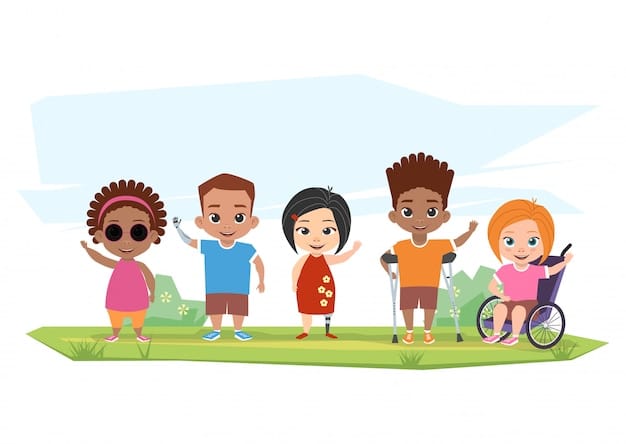State Children’s Health Insurance Program (SCHIP): Your Guide to Coverage

The State Children’s Health Insurance Program (SCHIP), now known as the Children’s Health Insurance Program (CHIP), provides low-cost health coverage to children in families who earn too much to qualify for Medicaid but cannot afford private insurance, ensuring they receive essential healthcare services.
Are you concerned about your children’s access to quality healthcare? The State Children’s Health Insurance Program (SCHIP), currently known as the Children’s Health Insurance Program (CHIP), offers a lifeline for families needing assistance. Let’s explore how this program can help.
Understanding the State Children’s Health Insurance Program (SCHIP)
The State Children’s Health Insurance Program, or SCHIP, isn’t always well-understood, although many know of CHIP. It is crucial to comprehend the program in order to see whether your children could be eligible for assistance. By providing financial aid for healthcare, SCHIP hopes to guarantee children’s welfare and healthy development.
What is the Primary Goal of SCHIP?
The primary goal of SCHIP is to provide low-cost health coverage to children in families who earn too much to qualify for Medicaid but cannot afford private insurance. This helps ensure that more children have access to necessary medical care.
Who is Eligible for SCHIP?
Eligibility for SCHIP typically depends on a family’s income level and the state in which they reside. Generally, children under the age of 19 who are not eligible for Medicaid and do not have other health insurance coverage may qualify. The specifics vary by state, so it’s essential to check your local guidelines.

- Income limits: Families must meet specific income thresholds, which vary by state, to qualify for SCHIP.
- Age requirements: The program typically covers children under the age of 19.
- Residency: Children must reside in the state where they are applying for coverage.
Understanding the fundamentals of SCHIP is the first step in guaranteeing your children’s access to healthcare. By being aware of the program’s goals and eligibility requirements, you may decide with knowledge if it’s the best fit for your family.
Benefits Covered Under SCHIP
SCHIP provides extensive coverage for the medical requirements of your kids after they have been enrolled. It is intended to be easily accessible and comprehensive, covering everything from routine checkups to specialized treatments. It is vital to comprehend the precise advantages offered by the program in order to fully utilize its possibilities.
Comprehensive Medical Care
SCHIP typically covers a wide range of medical services, including doctor visits, immunizations, hospital care, and prescription medications. The exact benefits can vary by state, but the goal is to provide comprehensive healthcare coverage to children.
Preventative Services
Preventative care is a significant element of SCHIP, with a focus on early identification and treatment of illnesses and health issues. Regular check-ups, vaccinations, and screenings are typically covered. These treatments are essential for maintaining your children’s health and well-being.
- Well-child visits: Regular check-ups to monitor growth and development.
- Immunizations: Vaccines to protect against common childhood diseases.
- Screenings: Tests to detect potential health issues early on.
- Dental and vision care: Many SCHIP programs also include dental and vision benefits.
SCHIP guarantees that youngsters receive the medical attention they require to thrive by providing a wide array of services. Knowing precisely what is covered allows you to make well-informed choices regarding your children’s healthcare.

How to Apply for SCHIP
Knowing how to apply for SCHIP is a crucial step in securing health coverage for your children. The application process can seem daunting, but with the right information, it can be straightforward. Each state manages its SCHIP program, so the specific steps may vary.
Researching Your State’s Program
Begin by researching your state’s specific SCHIP program. You can typically find this information on your state’s health department website or by contacting your local Medicaid office. Understanding the specific requirements and application process for your state is essential.
Gathering Necessary Documentation
Before you start the application, gather all necessary documentation. This typically includes proof of income, such as pay stubs or tax returns, as well as identification and proof of residency. Having these documents ready will help streamline the application process.
The process to apply can be summarized in the following steps:
- Complete the application form: Fill out the application form accurately and completely.
- Submit required documents: Provide all necessary documentation, such as proof of income and residency.
- Follow up: After submitting your application, follow up with the program to ensure it is being processed.
With the appropriate preparation, the application procedure may be efficiently traversed, guaranteeing that your children will soon have access to necessary healthcare. Being proactive and prepared makes a big difference in getting your application approved.
Common Challenges and Solutions
While SCHIP is a great resource for families, there are issues that people may encounter when using it. Being aware of these typical challenges and their possible solutions can assist families in efficiently utilizing the program and guaranteeing that their children have continuous access to medical treatment. Finding your way around bureaucracy and making sure you have continuous coverage are two of the biggest problems.
Navigating Bureaucracy
One common challenge is navigating the bureaucratic processes involved in applying for and maintaining SCHIP coverage. This can include paperwork, long wait times, and confusing regulations. To overcome this challenge, it’s essential to stay organized and persistent.
Maintaining Continuous Coverage
Another challenge is ensuring continuous coverage for your children. SCHIP eligibility must be renewed periodically, and any changes in your family’s income or circumstances can affect your eligibility. To avoid gaps in coverage, it’s important to stay informed about renewal deadlines and reporting requirements.
Some tips that can help with the bureaucracy include:
- Keep detailed records: Maintain copies of all application materials, correspondence, and medical records.
- Communicate effectively: Clearly communicate with program administrators and healthcare providers.
- Seek assistance: Don’t hesitate to ask for help from social workers or community organizations.
By being aware of these potential issues and taking proactive steps to address them, families may guarantee that SCHIP provides their children with consistent and dependable healthcare coverage.
CHIP Reauthorization and Future Prospects
The Children’s Health Insurance Program (CHIP), formerly known as SCHIP, depends on funding being renewed on a regular basis to guarantee that it can keep providing services to millions of youngsters. Awareness of these renewals’ repercussions as well as CHIP’s future prospects is crucial for families who depend on this vital program. Comprehending the dynamics of CHIP reauthorization is essential to maintaining the program’s ability to serve kids in need.
Impact of Reauthorization on Families
CHIP reauthorization has a direct impact on the availability of healthcare coverage for children from low-income families. When Congress reauthorizes CHIP, it ensures that funding is available for states to continue providing coverage. Failure to reauthorize CHIP can lead to funding shortfalls and potential disruptions in coverage.
Future of CHIP
The future of CHIP depends on ongoing political support and funding decisions. Advocacy efforts play a crucial role in ensuring that CHIP remains a priority for lawmakers. As healthcare policies evolve, it’s important to stay informed about potential changes to CHIP and their impact on families.
The reauthorization process is based on:
- Monitoring legislation: Stay informed about CHIP reauthorization efforts in Congress.
- Contacting lawmakers: Let your elected officials know that you support CHIP.
- Supporting advocacy groups: Join or support organizations that advocate for CHIP funding.
Families can have an impact on CHIP’s future by staying abreast of developments and advocating for its continuation. In order to maintain CHIP’s ability to assist children in the years to come, it is imperative to proactively guarantee its financing and backing.
Success Stories and Impact
The State Children’s Health Insurance Program has made a substantial difference in the lives of many families and children since its foundation. Seeing these achievements can inspire and highlight the value of this initiative. The anecdotes and data provide strong support for CHIP’s sustained funding and effectiveness in enhancing children’s health results.
Real-Life Success Stories
Numerous families have benefited from SCHIP, gaining access to healthcare services they otherwise could not afford. These stories illustrate the program’s positive impact on children’s health and well-being.
Statistical Data on Program Impact
Statistical data further supports the effectiveness of SCHIP. Studies have shown that children enrolled in SCHIP have better health outcomes, including fewer hospitalizations and improved access to preventative care. These statistics demonstrate the significant impact of SCHIP on children’s health.
- Improved health outcomes: Children enrolled in SCHIP have better overall health compared to those without coverage.
- Reduced hospitalizations: Access to preventative care through SCHIP leads to fewer hospital visits.
- Increased access to care: SCHIP ensures that more children have access to necessary medical services.
When thinking about the future of children’s healthcare coverage, these findings are extremely important. The program continues to be essential in guaranteeing that every child has the chance to thrive and be healthy because of its proven success and significant influence.
| Key Point | Brief Description |
|---|---|
| ✔️ Eligibility | Income and age requirements vary by state. |
| ⚕️ Benefits | Covers doctor visits, immunizations, and hospital care. |
| 📝 Application | Apply through your state’s health department website. |
| 🏛️ Reauthorization | Continued funding is crucial for program sustainability. |
Frequently Asked Questions (FAQ)
▼
Income limits for SCHIP vary by state. Generally, it covers families who earn too much to qualify for Medicaid but cannot afford private insurance. Contact your state’s health department for specific income thresholds.
▼
SCHIP typically covers children under the age of 19. However, specific age requirements may vary slightly by state. Check with your state’s program to confirm the exact age range covered.
▼
SCHIP covers children with pre-existing conditions. There are no exclusions based on pre-existing health issues. Your child will receive the necessary medical care regardless of their health history.
▼
SCHIP coverage typically needs to be renewed annually. Your state’s program will notify you of the renewal deadline and any required documentation. Make sure to complete the renewal process on time to avoid gaps in coverage.
▼
In many cases, you can choose your child’s doctor with SCHIP. The program often has a network of providers, and you can select a doctor within that network. Check with your state’s program for specific details on choosing a doctor.
Conclusion
The State Children’s Health Insurance Program (SCHIP) is a crucial resource for ensuring that children from low-income families receive quality healthcare. By understanding the program’s benefits, eligibility requirements, and application process, families can take advantage of this valuable support to keep their children healthy and thriving.





